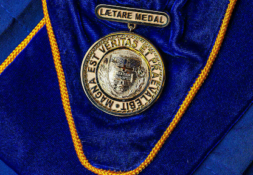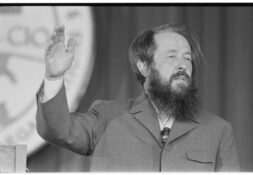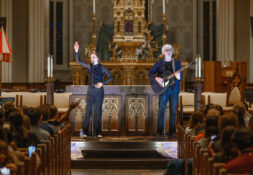Undergraduate complaints about graduate students’ teaching and grading are common. These courses are sometimes regarded as inferior to courses taught by regular faculty.
Suzann Petrongolo, a film, television, and theatre major and Italian minor, said that a graduate student’s ultimate focus is his own coursework rather than those he is teaching.
“I think that they’re students too and that they have their own responsibilities and that they’re just as responsible for their coursework as we are,” she said.
Courtney Cox, a junior political science and American studies major, holds a more favorable opinion of graduate students.
“Some of my best teachers have been graduate students,” she commented. “I think that because they’re less practiced in what they’re teaching they’re open to hearing a student’s point of view and it often leads to a more fluid discussion.”
Notre Dame awarded graduate degrees in the decades following its establishment in 1842, but the real push to become a research institution began with then-University President Fr. Theodore Hesburgh, CSC. From 1952 to 1987, the period of Father Hesburgh’s presidency, research funding increased from $735,000 to $15 million.
Current University President Fr. John I. Jenkins, CSC, has continued this focus on enhancing Notre Dame’s research activity.
The Notre Dame Office of Strategic Planning and Institutional Research currently reports that teaching assistants (TAs) generate approximately 25 percent of credit hours in lower division Arts and Letters courses. In comparison, senior full time faculty members teach 33.34 percent of lower division courses.
The presence of teaching assistances is reduced in upper division courses, where they are responsible for approximately 4 percent of all classes. In total, teaching assistants are responsible for 16.74 percent of arts and letters courses, and senior faculty are responsible for approximately 35 percent.
How do departments work to reconcile the desire to provide graduate students with experience and the need to offer a high quality undergraduate education?
Daniel Graff, director of undergraduate studies of the history department, described his department’s “small but vital graduate program.” History graduate students typically work as a teaching assistant (TA) in their second or third year and may teach an undergraduate course in their fourth, fifth, or sixth year.
“We try to structure courses with tutorials if they have TAs to give the TAs a chance to lead some discussions and start to learn to teach,” said Graff, but “the faculty member still oversees the course and is responsible for the final grade as well as training the TA.”
Graff pointed out that the opportunity to teach is an important component of the graduate experience.
“An active part of our graduate training is to try to give every graduate student the opportunity to teach a course on their own because its important for them to develop as teachers and acquire the skills; its also important for their professional success,” he said.
According to Graff, the percentage of history classes taught by graduate students is about 10 percent.
Such a small percentage eases the tension between graduate experience and undergraduate education, Graff said. “We don’t face that tension because the graduate program is so small that only a few of our courses are ever offered by graduate students,” he commented.
Richard Jensen, chairman of the department of economics, echoed Graff’s comments.
“[Teaching] gives them hands-on experience as teacher-scholars and as such makes them more attractive to prospective employers,” he said.
Jensen also said that using graduate student instructors also allows the department to offer smaller classes.
“Our use of graduate students in their own classes is not based solely on a desire to give them experience,” he said. “Rather, we have our advanced graduate students teach their own classes because we think smaller class sizes are conducive to a high quality undergraduate experience.”
Within the economics department, fourth or fifth year graduate students teach 9 out of the 39 classes offered this semester. Furthermore, Jensen said that “4 of [their] graduate students have won Kaneb awards for teaching excellence.”
Graduate student instructor Erin Drew of the English department said that being closer to her students’ age is an advantage.
“I remember being an undergraduate more vividly, and my undergraduate experiences have much more in common with current students than those of a professor who graduated in the 70’s or 80’s,” she said. “Those memories definitely inform my teaching, especially my one-on-one interactions with students.”
Mendoza College of Business does not have a PhD program, so all of its post-baccalaureate students are working towards their MBA or MSA.
According to Richard Mendenhall, the department chair of the finance department, graduate students do not singlehandedly teach any finance classes.
In regard to graduate student TAs, Mendenhall commented, “Some students help with teaching and some with research, but, if they help with teaching, they mostly grade homework assignments or help to set up projects. I doubt that any play a significant role in classroom instruction.”
Helena is an economics major living in Badin Hall. You can reach her at hbirdsel@nd.edu.





